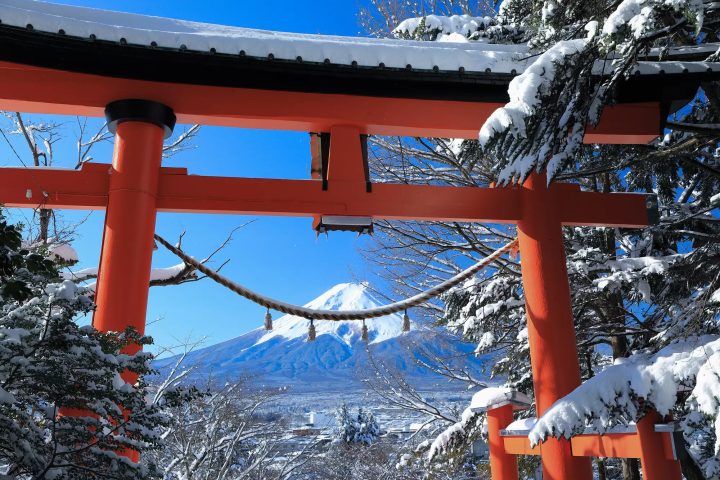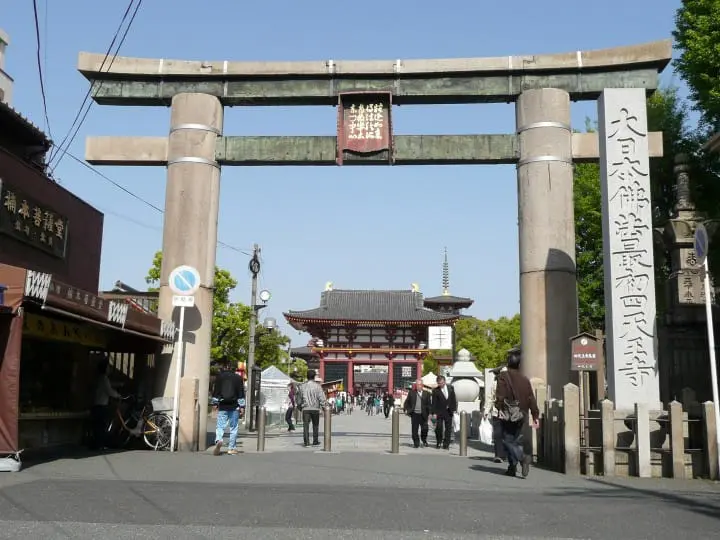Torii: Shinto Shrine Gates in Japanese Culture

Whenever you visit a Shinto shrine, you will most likely encounter a large gate-like structure out front, called a torii. Why are they built at shrines and what do they represent? Learn about these points in this article, as well as some of the famous torii in Japan.
What are Torii Gates?

Photo by Pixta
Shinto shrines in Japan often have large, gate-like structures standing boldly at their front entrances. These are known as "torii" in Japanese.
In this article we will explain the history and origins of these fascinating torii gates and will introduce several famous torii you can see in Japan.
Japan's Torii Gates
Torii - The Gates to Shinto Shrines
The Origin of Torii in Japan
The Many Famous Torii Gates in Japan
1. The Torii at Kinpusenji Temple, Nara
2. The Great Torii at Itsukushima Shrine, Hiroshima
3. The Stone Torii at Shitennoji Temple, Osaka
4. The Senbon Torii at Fushimi Inari Shrine, Kyoto
5. Meoto Iwa at Futami Okitama Shrine, Mie
6. The Stone Torii Gate of Kumano Hongu Taisha, Wakayama
7. The Kuroki Torii Gate of Nonomiya Shrine, Kyoto
Torii - The Gates to Shinto Shrines

Photo by Pixta
Shrines are thought to be where the gods of Japan reside, and torii are said to be the division between the sacred precincts of the shrine and the human world. In other words, torii are the front door to the home of the gods.
The standard torii gate is formed with two tall pillars, a large horizontal crossbar connecting the two pillars, and a cap piece resting on top of them.
Shrines can have either one or multiple torii on its premises. If a Shrine has more than one torii, the torii on the outermost side is considered the first gate, and the gates count up as you get further into the shrine precincts.
You may sometimes see that Buddhist temples also have torii on their precincts. These date back to the times when the Buddhist and Shinto faiths had merged into a syncretic religion. The gates at these temples usually have a different structure than torii gates and are often referred to as "sanmon."
Visitors often bow before a torii when visiting a shrine to show respect or honor towards the sanctity of the shrine. They usually bow again before they pass through the torii when leaving.
The Origins of Torii in Japan

Photo by Pixta
Various theories exist for explaining the origins of torii. One of the most well-known ideas comes from Japanese mythology.
In Japanese mythology, there is a story called Ama-no-iwato. After some struggles with her family, Amaterasu, the Sun Goddess, hid herself away inside a cavern called Ama-no-iwato, thus plunging the world into darkness.
The other gods and goddesses did everything they could to try and draw Amaterasu out from the cavern. After a great number of attempts, what finally succeeded in bringing her out into the world again was the sound of birds singing as they sat in the wild mistletoe growing outside of the cavern entrance way.
The deities of Japan are thought to reside beyond the trees where birds sit, resulting in the name torii. "Torii" is written with the characters for "bird" (鳥) and "reside" (居) in kanji characters.
↑ Return to the top of article.
The Many Famous Torii Gates in Japan
Of all the shrines in Japan with their respective torii, the ones listed here are some of the shrine gates that are considered the most famous.
1. The Torii at Kinpusen-ji Temple, Nara

Photo by Pixta
Our first famous torii is found at Kinpusen-ji Temple (a syncretic Shinto and Buddhist temple) in front of the Zao-do hall in Yoshino, Nara prefecture. It has been recognized as an Important Cultural Property in Japan and stands a great eight meters tall.
2. The Vermilion Grand Torii at Itsukushima Shrine, Hiroshima

Photo by Pixta
This bright vermilion torii stands on the waters of Itsukushima Shrine in Miyajima, an island in Hiroshima Prefecture. It is the largest wooden torii gate in Japan, known as the "Great Torii of Miyajima" or "Itsukushima Shrine's Torii Gate."
Being one of the most famous sights of Japan, the current torii standing here is actually the eighth generation of the shrine gate, most recently having been constructed in 1875. The history of the Great Torii dates back centuries, and although its exact construction date is not exactly known, it is believed to have been standing since at least from the 12th century.
Not only has this shrine and its torii been recognized as an Important Cultural Property in Japan, but it's also recognized as a UNESCO World Heritage site as well. Standing 16.6 meters tall (about 52 feet), it is referred to as a grand torii for its size and stands as Japan's largest wooden gate.
One of the most remarkable qualities about this Great Torii is its appearance during high tide, when it appears to "float" on the surface of the water. This phenomenon occurs because the gate stands directly in the waters of the Seto Inland Sea. Visitors can witness this breathtaking sight as the tide rises and falls, creating a surreal and picturesque scene.
Itsukushima Shrine has recently undergone repairs between 2019 and 2022.
Read also
↑ Return to the top of article.
3. The Stone Torii at Shitenno-ji Temple, Osaka

This 8.5 meter (28 feet) tall torii is located at Shitenno-ji Temple in Tennoji, Osaka. Built in 1294, this shrine gate stands as the oldest grand torii made from stone in all of Japan, and is of course registered as an Important Cultural Property as well.
↑ Return to the top of article.
4. The Senbon Torii at Fushimi Inari Shrine, Kyoto

At Fushimi Inari Shrine located in Fushimi, Kyoto, you'll find several thousand torii lined up one after another. These gates follow the path leading up the mountain, which is said to sit at the division between our world and the realm of the dead, which is why there are so many barriers (gates) lining this route. This series of torii was dedicated by the worshipers of the shrine from the Edo era to the Meiji era. It is said that there are about ten thousand shrine gates located throughout Fushimi Inari Grand Shrine.
↑ Return to the top of article.
5. Meoto Iwa, Futami Okitama Shrine, Mie

Photo by Pixta
The Meoto Iwa or "married couple stones" are found in Futamicho, Ise, Mie, by the Futami Okitama Shrine. Not strictly shaped like a standard shrine gate, these rocks are regarded as serving as the boundary between the inner sanctum of a Shinto shrine and the rest of the world.
Beyond the Meoto Iwa, along the ocean horizon you can watch the sunrise each morning, and about 700 meters into the ocean from these sacred rocks you will also find the miraculous Okitama Shinseki, a large flat rock that the waves just break over. The Meoto Iwa are said to be the gateway between the realm of the gods and our world.
↑ Return to the top of article.
The Stone Torii Gate of Kumano Hongu Taisha, Wakayama

Photo by Pixta
The largest stone torii gate in Japan is known as the "Stone Torii Gate of Kumano Hongu Taisha." Located in Tanabe City, Wakayama Prefecture, it serves as the starting point of the Kumano Kodo pilgrimage routes.
Having been constructed early in the Edo period, one of the main highlights of this stone torii gate is its sheer size and imposing presence. Standing at approximately 33.9 meters (about 111 feet) tall, this stone torii gate is renowned as the largest of its kind in Japan.
The gate itself also features intricate carvings of birds on its upper portion, adding to its aesthetic appeal and attracting numerous visitors.
Additionally, Kumano Hongu Taisha is one of the three grand shrines of Kumano, historically revered and attracting pilgrims for centuries. Thus, the stone torii gate serves as a symbolic entrance to this sacred site, embodying its dignity and significance.
Why though, was this gate built to be so big? One possibility is with Kumano Hongu Taisha being a long revered shrine, they may have built this large gate to express the shrine's sanctity and grandeur. Moreover, with it being situated at the starting point of the Kumano Kodo pilgrimage routes, the gate also served as a landmark for travelers, guiding them on their spiritual journey. Therefore, the sizable torii gate may have played a role in providing reassurance and indicating the destination for pilgrims and travelers alike.
↑ Return to the top of article.
The Kuroki Torii Gate of Nonomiya Shrine, Kyoto

Photo by Pixta
Nonomiya Shrine is located in Sagano, Kyoto Prefecture, and has been a place of worship for local communities for many years. One of the notable features of this shrine is its distinctive torii gate, known as the Kuroki Torii Gate.
The Kuroki Torii Gate is made out of wood, but stands out from other torii gates due to its black color. It was crafted using a special technique where the wood is first burned and then finished with lacquer, resulting in a beautiful, dark and glossy finish. This unique appearance gives the gate a sense of elegance and presence that sets it apart from others.
This shrine and its torii attracts attention from tourists and worshippers alike due to its distinctive appearance and dignified aura. Passing through this gate gives visitors a sense of reverence and sacredness. Moreover, it harmonizes beautifully with the natural environment surrounding it, adding to its allure.
Historically, Nonomiya Shrine has been revered as a guardian deity by local communities. Therefore, the Kuroki Torii Gate serves as a symbol of the shrine's history and depth of faith, holding special significance for the people of the region.
↑ Return to the top of article.
Sacred Torii Gates in Japan
Torii, as mentioned above, are considered to be the border between the mortal and godly realms of Japan. When you next visit a Shinto shrine, why not spend a little time observing the torii itself too?
日本への訪日外国人の方が、もっと増えますように!










































![[Coupon Available] Attention Overseas Winter Sports Fans! Nagano's Sports Depot Has Evolved](https://resources.matcha-jp.com/resize/720x2000/2026/01/05-254819.webp)
![[2 hours from Tokyo ] 10 Quiet and Breathtaking Views of Mount Fuji in Yamanashi Hokuto City , Yamanashi - Part 2](https://resources.matcha-jp.com/resize/720x2000/2025/12/16-253037.webp)
